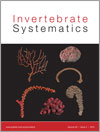The genus Metania comprises 11 species of freshwater sponge that are distributed circumtropically: five are Neotropical, three Afrotropical, two Oriental and one Australian. Here we infer the phylogeny of the genus Metania and examine the processes that lead to the current biogeographic distribution using cladistic analysis. One matrix with 26 morphological characters was analysed using the TNT software, and resulted in two most parsimonious cladograms (strict consensus). Our results support monophyly of Metania due to two characters unique to the genus: presence of acanthoxeas and presence of spines in the shaft of the gemmoscleres. Also, the genera Drulia and Houssayella were synonymised with Metania. The family Metaniidae – allocated in the recently proposed order Spongillida – now contains three genera: Acalle Gray, 1867, Metania Gray, 1867 and Corvomeyenia Weltner, 1913. Brooks parsimony analysis of Metania resulted in a single area cladogram showing a Gondwanan pattern: (Neartic (Australian (Oriental (Afrotropical, Neotropical)))) and thus the current distribution is explained by the breakup of Gondwana.
How to translate text using browser tools
28 August 2015
Microscleres and gemmoscleres as phylogenetic signals in Spongillida: phylogeny and biogeography of the genus Metania Gray, 1867 (Porifera, Metaniidae)
Cristiana Castello-Branco,
Adolfo Ricardo Calor,
Carla Menegola
ACCESS THE FULL ARTICLE

Invertebrate Systematics
Vol. 29 • No. 4
August 2015
Vol. 29 • No. 4
August 2015
cladistics
freshwater sponges
Gondwanan distribution
systematic




